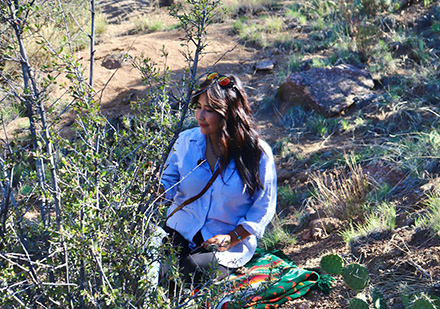By Cherie L. De Vore, Ph.D.

There was a time before academia when I frequently wrote poetry and personal short stories. Writing this narrative about my formative experiences in environmental health research has been a restorative practice, a common theme as I grow in my career.
My identity as an Indigenous woman from the four sacred mountains of Dinetah (Navajo land) is paramount to the type of mentor, teacher, and scientist I have become. I grew up in a beautiful high-country community along the continental divide near Crownpoint, New Mexico. It's an area called Tsinaayalk'id, named for a space where people would come together to gather wood. Our clan and homestead still occupy the same region to this day. Though our community is physically and socially remote, the landscape and climate keep us strong. We become as resilient as the land and mountains that shape us.
Resource extraction, including uranium, coal, and natural gas, has affected several Dine (Navajo) communities. I became interested in these issues at a young age as I navigated the windy mesas and abandoned pits in my backyard. The current generation of Indigenous people globally is trying to figure out how to solve the nuclear waste problem that was bequeathed to us by previous generations.
A ban on new mining has been enacted by Navajo Nation but, the storage of waste from previous extraction activities is another critical issue. For years, reservations have been targeted as sites to store nuclear waste, and tons of waste piles sit unreclaimed throughout Navajo. Up to three-quarters of all abandoned mines in the western U.S. are located near federal and tribal lands, representing a unique risk of exposure for our people. How to deal with legacy waste material and how to remediate contaminated sites are some of the pressing questions I contemplate about environmental health work and holistic community wellness.
Indigenous scientists, like myself, are barely beginning to understand the transport and mechanistic insights of hazardous contaminants, along with remediation technologies that are appropriate for our communities. Aside from basic site characterization, we have a lot of collaborative work to do to advance knowledge about viable reclamation, which will likely not be done in our lifetime. What we can do now, however, is restorative work.
My research focus has been to integrate microscopy, advanced spectroscopy, molecular biology, aqueous chemistry, and speciation tools to identify governing biogeochemical mechanisms affecting the release and bioavailability of metal contaminants in plants, soil, and waterways near communities like mine. For example, results from a recent study in review highlight the important role of microbial reduction and community diversity in controlling release of metal (arsenic, iron, and manganese) from mine waste sediment after transitioning from aerobic to anaerobic redox conditions. The environmental samples used in these batch incubations were collected from regions of the watershed on Indigenous land that house medicinal plants and food resources.
Another study illustrates the role of endophytic fungi in significantly enhancing root length and biomass production in little bluestem grass, enabling the inoculated plants to better tolerate arsenic. The implications of these changes were more sites for adsorption and precipitation reactions with calcium-phosphorous and magnesium-phosphorus minerals that could accumulate arsenic after being exposed in hydroponic media. The results from this hydroponic investigation with a plant culturally relevant to the watershed can be useful for remediation applications that make use of the interaction of fungi and plants for uptake and accumulation of metals.
Understanding these mechanisms and pathways provides insight about environmental health initiatives and potential ecosystem recovery. This is challenging because environmental health research about Indigenous communities is often communicated from a narrative of destruction, loss, and despair. Incorporating Indigenous narratives can help researchers diversify our environmental discourse, and this is where my identity as an Indigenous scientist is critical.
My goal is to change the educational paradigm around environmental work and reclamation strategies as self-determining and restorative among Indigenous people and our collaborators. Engineered and natural systems that include wildland soils and agricultural and community spaces can diversify food, energy, and water sources to improve long-term social and environmental wellness. Active management strategies that integrate multiple knowledge systems can help control contaminant movement during scenarios like mining or wildfires.
I also believe that our unique perspectives and narratives as Indigenous people are valid forms of knowledge and higher knowing. I would like my research and pedagogy to come from a narrative of restorative balance, courage, and empowerment in the face of difficulty. Ultimately, the love of my people and our ways of life inspire me to find unique ways to tell these stories.
I would like to acknowledge my grandparents, parents, and community. I would not be without the foresight of our Old People and Holy Ones. To those Indigenous investigators, dreamers, builders, restorers, creators, innovators, and engineers: May you continue to be and walk in Hozho - beauty, harmony, balance.


